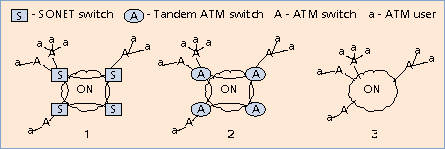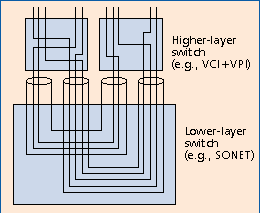Optical WANs
Here the main
interest is in the role optical networks (Fig.4) might play in
future wide area BBNs, namely, backbone networks where it now seems
clear that ATM and IP will play a major role.

Figure 4 - Target physical optical
transport network architecture (WAN)
In the most
ambitious vision, very large ATM/IP switches are directly
interconnected with fibers; in this scenario, all switching/routing
is done at the ATM/IP layer. However, long distance fiber links
today contain bundles of tens of fibers, each of which can support
transmission rates of up to 10 Gb/s. This could lead to WAN nodes
being required to support hundreds of gigabits per second of
traffic, which is currently impractical using only ATM/IP switches
(Fig. 2). In addition, WANs tend to be sparsely connected,
and therefore only a small fraction of the ATM/IP traffic may
terminate at a node. In these situations, it is far more practical
and economical to build a hierarchical ATM/IP over SDH network where
ATM/IP switches connect to SDH cross-connects, which in turn are
interconnected by fibers.

Figure 5 - Generic BBN alternatives

Fig. 6 - Layered multiplexing.

Fig. 7 - Layered switching
architecture

Figure 8- Layered traffic and
statistical gain
With the introduction of long-haul
WDM and OTDM technology, the bandwidth through a node may exceed
several terabits per second. It seems likely that some form of
optical switching services would be useful in switching these large
bandwidths. The questions we address below are which optical
services should be supported, and how this choice affects the
overall BBN architecture.
|








